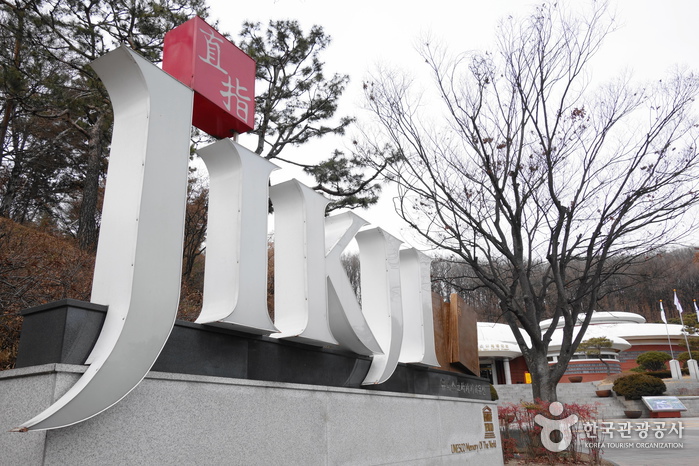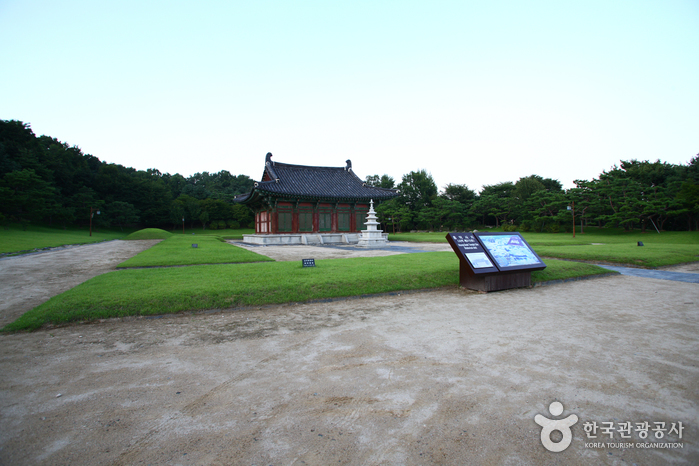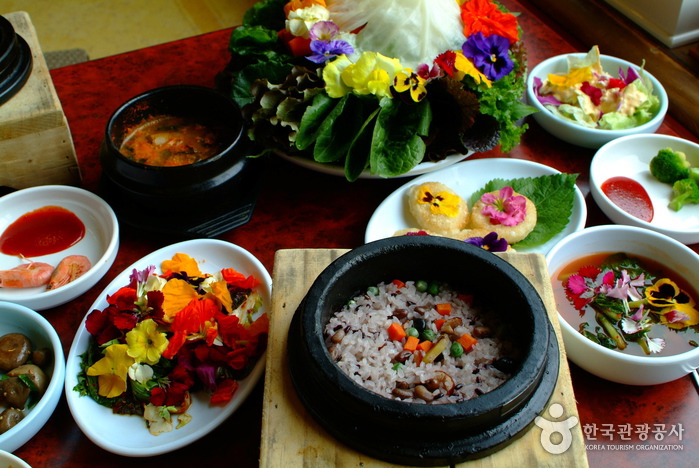Mireuseom Island (미르섬)
18.7 Km 0 2023-10-27
368 Geumbyeok-ro, Gongju-si, Chungcheongnam-do
Mireuseom Island is covered in a blanket of beautiful plants every fall, from cosmos to pink muhly, broom cypress and pearl millet. The pink muhly growing along the Geumgang River is a popular photo spot. The beautiful landscape unfolds the longer you walk towards Gongjudaegyo Bridge.
E-Mart - Cheongju Branch [Tax Refund Shop] (이마트 청주)
18.9 Km 0 2024-04-22
2F, #91, 147, Gijanghaean-ro, Gijang-eup, Gijang-gun, Busan
-
Cheongju Early Printing Museum(청주고인쇄박물관)
19.3 Km 0 2023-10-26
713, Jikji-daero, Heungdeok-gu, Cheongju-si, Chungcheongbuk-do
The city of Cheongju, together with UNESCO, commemorates the inscription of "Jikji" onto the UNESCO Memory of the World Register and presents the UNESCO/Jikji Memory of the World Prize to individuals and organizations that have made significant contributions to the preservation and utilization of the UNESCO Memory of the World, thereby promoting the great cultural heritage of Cheongju, the birthplace of movable metal type, and Korea in general. “Jikji,” or Jikji Simche Yojeol: Anthology of Great Buddhist Priests' Zen Teachings, is the oldest book in the world to be printed with movable metal type.
The Exhibition Center for Modern and Contemporary Printing introduces how the history of Korean printing has developed, starting from the introduction of lead type at the end of the 19th Century to the present-day Korean printing technology and its future directions. It is a place where one can learn how the Korean printing culture came to be in modern times, and what directions it will take as the world moves forward. Printing experience classes for children, families, and adults are available. They are expected to assist the visitors in understanding modern and contemporary printing culture.
Cheongju Early Printing Museum (Heungdeoksaji Temple Site) (청주 고인쇄박물관(흥덕사지))
19.3 Km 18778 2019-03-19
713, Jikji-daero, Heungdeok-gu, Cheongju-si, Chungcheongbuk-do
+82-43-201-4266
This early printing museum, located on the site of Heungdeoksa Temple in which Jikji, the world's oldest extant book, printed by movable metal type, was printed, was founded on March 17, 1992. Since the technology’s inception, Korea has substantially developed its metal-type printing methods. In this museum, approximately 650 artifacts including ancient movable metal and wooden print books from the Goryeo and Joseon periods, relics from the Heungdeoksaji Temple site (흥덕사지) and printing tools are on display. Here, visitors can learn about the history of the Korean printing technologies and culture.
In addition to exhibition, the museum has been promoted to hold the Cheongju International Printing & Publishing Fair, to study early printing culture and printing types and to publish museum journals and early printing-related papers.
Cheongju Heungdeoksa Temple Site (청주 흥덕사지)
19.3 Km 21014 2020-03-27
713, Jikji-daero, Heungdeok-gu, Cheongju-si, Chungcheongbuk-do
+82-43-201-2022
A large number of relics were unearthed at this site due to a land development project in 1985. Work was halted and relics were excavated by the Cheongju University Museum. The time and size of Heungdeoksa
Temple is unknown, but according to Jikji (Buljojikjisimcheyojeol, the world’s oldest existing book printed with movable metal type), the
excavated books were printed using metal types at the temple in the third year of King Uwang’s reign (1377). The books were published 78 years earlier than Gutenberg’s invention.
In 1972, the Jikji was officially recognized as the world’s oldest book printed with movable metal type during the International Book Year. The Buljojikjisimcheyojeol is
currently kept at the National Library of France.
HONG WHI KWAN[Korea Quality] / 홍휘관[한국관광 품질인증/Korea Quality]
19.4 Km 139 2020-11-19
6-6, Baengmigoeul-gil, Gongju-si, Chungcheongnam-do
+82-10-9701-3141, +82-41-858-8890
Located in Gongju, South Chungcheong Province, Hongwhikwan offers guests a traditional “hanok” experience filled with the gentle scents of red clay and wood. The hotel is located in front of the UNESCO World Heritage site Gongsanseong Fortress, with Geumgang River flowing behind the complex.
There are six rooms in total, all Korean-style with floor bedding for double, triple, and quadruple occupancy. High ceilings and exposed girders greet visitors upon entering the rooms that are decorated with traditional bedding, Korean paper windows, elegant muslin curtains, and colorful cushions. Each room is equipped with a TV set, a refrigerator, and a bathroom with a hairdryer, making it an ideal place to start and end the day. The spacious courtyard also comes with traditional games like “jegi chagi” and “yutnori.” Coffee and Korean tea are found in the second-floor community room, while the kitchen serves complimentary breakfast every morning with a simple menu of toast, beverages, fruits, and breakfast cereals. Furthermore, the complex is close to major tourist sites, such as the Gongjusanseong Market, Gongju National Museum, the UNESCO World Heritage site Ancient Tombs in Songsan-ri, and Tomb of King Muryeong. Hongwhikwan also offers free bicycle rentals for guests to stroll around the location.
Homeplus - Ochang Branch [Tax Refund Shop] (홈플러스 오창)
19.4 Km 0 2024-04-22
8-11, Jungsimsangeop 1-ro, Ochang-eup, Cheongwon-gu, Cheongju-si, Chungcheongbuk-do
-
Guard-Changing Ceremony of Woongjinseong Fortress (웅진성수문병 근무교대식)
19.4 Km 2090 2022-12-21
280, Woongjin-ro, Gongju-si, Chungcheongnam-do
• 1330 Travel Hotline: +82-2-1330 (Korean, English, Japanese, Chinese) • For more info: +82-41-856-7700
The Guard-Changing Ceremony of Woongjinseong Fortress takes place at Gongsanseong Fortress, a part of the Baekje Historic Areas which is a desginated UNESCO's World Heritage Site. The ceremony reenacts the service of the guards defending the castle, using costumes and props based on the strict analysis of the historical records. The ceremony is held every Saturday and Sunday from April to November except during hot summer season of June to August, and conducted every day during the Baekje Culture Festival in the fall. The event includes martial art performances and various experiences as well as the main ceremony, aiming at promoting Gongju-si, where the Baekje culture flourished, and its valuable heritage Gongsanseong Fortress.
Gongju Gongsanseong Fortress [UNESCO World Heritage] (공주 공산성 [유네스코 세계문화유산])
19.4 Km 42027 2024-03-15
280 Ungjin-ro, Gongju-si, Chungcheongnam-do
+82-41-856-7700
Gongsanseong Fortress is a fortification situated at the heart of Gongju, which served as the capital of the ancient Baekje kingdom (18 BCE - 660 CE) from 475 to 538. Even after Baekje's fall, subsequent dynasties such as Silla (57 BCE - 935 CE), Goryeo (918-1392), and Joseon (1392-1897) continued to use Gongju as a regional administrative center. As a result, numerous historical sites have accumulated in the area over time. From the fortress, visitors can enjoy a panoramic view of Gongju’s city center and the Geumgang River.
Gomanaru 1999 (고마나루1999)
19.5 Km 8874 2024-02-28
5-8 Baengmigoeul-gil, Gongju-si, Chungcheongnam-do
+82-41-857-9999
Gomanaru 1999 is a Korean restaurant located near Gongsanseong Fortress. Their menu features a single set meal called gomanaru bapsang (rice and side dishes), which includes a hearty spread of pot rice, boiled pork slices, grilled marinated pork shoulder, and grilled dried pollack. Using rice from Gongju, the rice is flavorful and nourishing, complemented by fresh vegetables from Jirisan Mountain, making for a healthy meal. Rice is considered a staple in Korean cuisine, and Jirisan Mountain is renowned as a pristine region, making the food here particularly special.

![E-Mart - Cheongju Branch [Tax Refund Shop] (이마트 청주)](http://tong.visitkorea.or.kr/cms/resource/46/2883146_image2_1.jpg)


![HONG WHI KWAN[Korea Quality] / 홍휘관[한국관광 품질인증/Korea Quality]](http://tong.visitkorea.or.kr/cms/resource/57/2651357_image2_1.jpg)
![Homeplus - Ochang Branch [Tax Refund Shop] (홈플러스 오창)](http://tong.visitkorea.or.kr/cms/resource/62/2882962_image2_1.jpg)
![Gongju Gongsanseong Fortress [UNESCO World Heritage] (공주 공산성 [유네스코 세계문화유산])](http://tong.visitkorea.or.kr/cms/resource/75/2678675_image2_1.jpg)

 English
English
 한국어
한국어 日本語
日本語 中文(简体)
中文(简体) Deutsch
Deutsch Français
Français Español
Español Русский
Русский